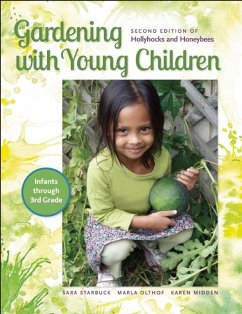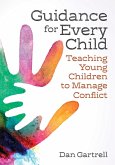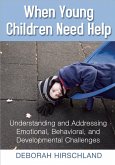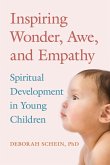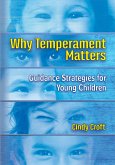- Broschiertes Buch
- Merkliste
- Auf die Merkliste
- Bewerten Bewerten
- Teilen
- Produkt teilen
- Produkterinnerung
- Produkterinnerung
Gardens are where children's imaginations engage nature, and the result is joyful learning. Use this book to explore the unique and expansive learning opportunities offered by gardening with children. Packed with colourful photographs and updated to address many childhood issues and gardening trends that have erupted in recent years, it reflects the growing concerns for children's nature deficit and the obesity epidemic.
Andere Kunden interessierten sich auch für
![Caring for Young Children with Special Needs Caring for Young Children with Special Needs]() Cindy CroftCaring for Young Children with Special Needs21,99 €
Cindy CroftCaring for Young Children with Special Needs21,99 €![Guidance for Every Child: Teaching Young Children to Manage Conflict Guidance for Every Child: Teaching Young Children to Manage Conflict]() Daniel GartrellGuidance for Every Child: Teaching Young Children to Manage Conflict31,99 €
Daniel GartrellGuidance for Every Child: Teaching Young Children to Manage Conflict31,99 €![Connecting Animals and Children in Early Childhood Connecting Animals and Children in Early Childhood]() Patty Born SellyConnecting Animals and Children in Early Childhood26,99 €
Patty Born SellyConnecting Animals and Children in Early Childhood26,99 €![Challenging Exceptionally Bright Children in Early Childhood Classrooms Challenging Exceptionally Bright Children in Early Childhood Classrooms]() Ann GadzikowskiChallenging Exceptionally Bright Children in Early Childhood Classrooms36,99 €
Ann GadzikowskiChallenging Exceptionally Bright Children in Early Childhood Classrooms36,99 €![When Young Children Need Help: Understanding and Addressing Emotional, Behavorial, and Developmental Challenges When Young Children Need Help: Understanding and Addressing Emotional, Behavorial, and Developmental Challenges]() Deborah HirschlandWhen Young Children Need Help: Understanding and Addressing Emotional, Behavorial, and Developmental Challenges36,99 €
Deborah HirschlandWhen Young Children Need Help: Understanding and Addressing Emotional, Behavorial, and Developmental Challenges36,99 €![Inspiring Wonder, Awe, and Empathy: Spiritual Development in Young Children Inspiring Wonder, Awe, and Empathy: Spiritual Development in Young Children]() Deborah ScheinInspiring Wonder, Awe, and Empathy: Spiritual Development in Young Children31,99 €
Deborah ScheinInspiring Wonder, Awe, and Empathy: Spiritual Development in Young Children31,99 €![Why Temperament Matters: Guidance Strategies for Young Children Why Temperament Matters: Guidance Strategies for Young Children]() Cindy CroftWhy Temperament Matters: Guidance Strategies for Young Children34,99 €
Cindy CroftWhy Temperament Matters: Guidance Strategies for Young Children34,99 €-
-
-
Gardens are where children's imaginations engage nature, and the result is joyful learning. Use this book to explore the unique and expansive learning opportunities offered by gardening with children. Packed with colourful photographs and updated to address many childhood issues and gardening trends that have erupted in recent years, it reflects the growing concerns for children's nature deficit and the obesity epidemic.
Hinweis: Dieser Artikel kann nur an eine deutsche Lieferadresse ausgeliefert werden.
Hinweis: Dieser Artikel kann nur an eine deutsche Lieferadresse ausgeliefert werden.
Produktdetails
- Produktdetails
- Verlag: Redleaf Press
- 2nd edition
- Seitenzahl: 238
- Erscheinungstermin: 13. Mai 2014
- Englisch
- Abmessung: 274mm x 211mm x 18mm
- Gewicht: 839g
- ISBN-13: 9781605541570
- ISBN-10: 1605541575
- Artikelnr.: 39410259
- Herstellerkennzeichnung
- Libri GmbH
- Europaallee 1
- 36244 Bad Hersfeld
- gpsr@libri.de
- Verlag: Redleaf Press
- 2nd edition
- Seitenzahl: 238
- Erscheinungstermin: 13. Mai 2014
- Englisch
- Abmessung: 274mm x 211mm x 18mm
- Gewicht: 839g
- ISBN-13: 9781605541570
- ISBN-10: 1605541575
- Artikelnr.: 39410259
- Herstellerkennzeichnung
- Libri GmbH
- Europaallee 1
- 36244 Bad Hersfeld
- gpsr@libri.de
Sara Starbuck: Sara Starbuck, EdD, is an associate professor in the Department of Human Environmental Studies and administrative director of the Early Childhood Centers for Training, Research, and Education at Southeast Missouri State University. Dr. Starbuck has over thirty years of experience in the field of early childhood education as a teacher educator, administrator, and teacher of young children, and she is deeply involved in connecting children to nature and helping adults understand the importance of nature in the children's lives. She earned her EdD from Nova Southeastern University in child and youth studies with a specialization in management of programs. Her BS and MS degrees are from Southern Illinois University, Carbondale, in early childhood education. Marla Olthof: Marla Olthof has nearly a decade of experience teaching toddlers and preschoolers and has trained a variety of teachers in a multitude of settings, including undergraduate practicum experiences and student teaching, at Southern Illinois University and the Purdue University Calumet Head Start Resource Center. Marla also enjoys volunteering in the classroom as the parent of three elementary school-aged daughters. Karen Midden: Karen Midden is a professor in plant, soil, and agricultural systems at Southern Illinois University, Carbondale. She is a landscape architect working in Illinois and teaches landscape design, designing outdoor spaces, and sustainable landscape practices. Her current research and projects include urban agriculture, green roofs, and vertical gardening.
Table of Contents
Chapter 1: Why Garden?
Children Need Nature
Physical, Social, and Emotional Development
Dirt Is Good
International Movement Toward Outdoor Nature Playscapes
From Seed to Table
The Role of the Teacher
Chapter 2: Engaging Children in Gardening
Fostering Children's Interest in Gardening
Using Emergent Curriculum as an Approach to Gardening
Assuring Intellectual Integrity
Using the Project Approach with Gardening
Being in the Garden with Children
Engaging Children in the Scientific Process
Fieldwork
Graphing with Children
Using Reference Materials
Technology and the Garden Study
Documenting What Children Learn
Bringing the Garden Curriculum Indoors
Chapter 3: Planning Your Garden
Developing the Garden Design
Selecting the Garden Site
Types of Gardens
The Final Choice
Garden Themes
Bird and Butter?y Garden
North American Garden
Kitchen Garden
Sensory Garden
Southwestern Garden
Dinosaur Garden
Chapter 4: Building Your Garden
Gathering Resources through Families and Community
Constructing Different Types of Gardens
Ground-Level Gardens
Raised Beds
Container Gardens
Vertical Gardens
Green-Roof Garden
Indoor Gardens
Plant Selection
Preventing Vandalism
Chapter 5: Working with Children in the Garden
Planting the Garden
Every Day in the Garden
Supervising Children in the Garden
Maintaining the Garden
Garden Creatures
Harvesting
Sharing the Garden with Others
Chapter 6: Gardening with Infants and Toddlers
Taking Infants and Toddlers Outside
How to Take a Walk with Infants and Toddlers
Choosing Plants for Infants and Toddlers
Bringing the Garden Inside
Chapter 7: Universal Garden Learning Experiences
Exploring Plants
Exploring What Plants Need to Grow
Exploring Garden Creatures
Appendix 1: Children's Books about Gardens and Garden Creatures
Appendix 2: Reference Books about Garden Creatures
Appendix 3: Garden and Environmental Education Books and Supplies,
Including Sources for Insects, Worms, and Other Beneficial Creatures
Appendix 4: Seeds and Garden Supplies
Appendix 5: Common and Botanical Names of Plants Mentioned
Appendix 6: Poisonous Plants
References
Index
Chapter 1: Why Garden?
Children Need Nature
Physical, Social, and Emotional Development
Dirt Is Good
International Movement Toward Outdoor Nature Playscapes
From Seed to Table
The Role of the Teacher
Chapter 2: Engaging Children in Gardening
Fostering Children's Interest in Gardening
Using Emergent Curriculum as an Approach to Gardening
Assuring Intellectual Integrity
Using the Project Approach with Gardening
Being in the Garden with Children
Engaging Children in the Scientific Process
Fieldwork
Graphing with Children
Using Reference Materials
Technology and the Garden Study
Documenting What Children Learn
Bringing the Garden Curriculum Indoors
Chapter 3: Planning Your Garden
Developing the Garden Design
Selecting the Garden Site
Types of Gardens
The Final Choice
Garden Themes
Bird and Butter?y Garden
North American Garden
Kitchen Garden
Sensory Garden
Southwestern Garden
Dinosaur Garden
Chapter 4: Building Your Garden
Gathering Resources through Families and Community
Constructing Different Types of Gardens
Ground-Level Gardens
Raised Beds
Container Gardens
Vertical Gardens
Green-Roof Garden
Indoor Gardens
Plant Selection
Preventing Vandalism
Chapter 5: Working with Children in the Garden
Planting the Garden
Every Day in the Garden
Supervising Children in the Garden
Maintaining the Garden
Garden Creatures
Harvesting
Sharing the Garden with Others
Chapter 6: Gardening with Infants and Toddlers
Taking Infants and Toddlers Outside
How to Take a Walk with Infants and Toddlers
Choosing Plants for Infants and Toddlers
Bringing the Garden Inside
Chapter 7: Universal Garden Learning Experiences
Exploring Plants
Exploring What Plants Need to Grow
Exploring Garden Creatures
Appendix 1: Children's Books about Gardens and Garden Creatures
Appendix 2: Reference Books about Garden Creatures
Appendix 3: Garden and Environmental Education Books and Supplies,
Including Sources for Insects, Worms, and Other Beneficial Creatures
Appendix 4: Seeds and Garden Supplies
Appendix 5: Common and Botanical Names of Plants Mentioned
Appendix 6: Poisonous Plants
References
Index
Table of Contents
Chapter 1: Why Garden?
Children Need Nature
Physical, Social, and Emotional Development
Dirt Is Good
International Movement Toward Outdoor Nature Playscapes
From Seed to Table
The Role of the Teacher
Chapter 2: Engaging Children in Gardening
Fostering Children's Interest in Gardening
Using Emergent Curriculum as an Approach to Gardening
Assuring Intellectual Integrity
Using the Project Approach with Gardening
Being in the Garden with Children
Engaging Children in the Scientific Process
Fieldwork
Graphing with Children
Using Reference Materials
Technology and the Garden Study
Documenting What Children Learn
Bringing the Garden Curriculum Indoors
Chapter 3: Planning Your Garden
Developing the Garden Design
Selecting the Garden Site
Types of Gardens
The Final Choice
Garden Themes
Bird and Butter?y Garden
North American Garden
Kitchen Garden
Sensory Garden
Southwestern Garden
Dinosaur Garden
Chapter 4: Building Your Garden
Gathering Resources through Families and Community
Constructing Different Types of Gardens
Ground-Level Gardens
Raised Beds
Container Gardens
Vertical Gardens
Green-Roof Garden
Indoor Gardens
Plant Selection
Preventing Vandalism
Chapter 5: Working with Children in the Garden
Planting the Garden
Every Day in the Garden
Supervising Children in the Garden
Maintaining the Garden
Garden Creatures
Harvesting
Sharing the Garden with Others
Chapter 6: Gardening with Infants and Toddlers
Taking Infants and Toddlers Outside
How to Take a Walk with Infants and Toddlers
Choosing Plants for Infants and Toddlers
Bringing the Garden Inside
Chapter 7: Universal Garden Learning Experiences
Exploring Plants
Exploring What Plants Need to Grow
Exploring Garden Creatures
Appendix 1: Children's Books about Gardens and Garden Creatures
Appendix 2: Reference Books about Garden Creatures
Appendix 3: Garden and Environmental Education Books and Supplies,
Including Sources for Insects, Worms, and Other Beneficial Creatures
Appendix 4: Seeds and Garden Supplies
Appendix 5: Common and Botanical Names of Plants Mentioned
Appendix 6: Poisonous Plants
References
Index
Chapter 1: Why Garden?
Children Need Nature
Physical, Social, and Emotional Development
Dirt Is Good
International Movement Toward Outdoor Nature Playscapes
From Seed to Table
The Role of the Teacher
Chapter 2: Engaging Children in Gardening
Fostering Children's Interest in Gardening
Using Emergent Curriculum as an Approach to Gardening
Assuring Intellectual Integrity
Using the Project Approach with Gardening
Being in the Garden with Children
Engaging Children in the Scientific Process
Fieldwork
Graphing with Children
Using Reference Materials
Technology and the Garden Study
Documenting What Children Learn
Bringing the Garden Curriculum Indoors
Chapter 3: Planning Your Garden
Developing the Garden Design
Selecting the Garden Site
Types of Gardens
The Final Choice
Garden Themes
Bird and Butter?y Garden
North American Garden
Kitchen Garden
Sensory Garden
Southwestern Garden
Dinosaur Garden
Chapter 4: Building Your Garden
Gathering Resources through Families and Community
Constructing Different Types of Gardens
Ground-Level Gardens
Raised Beds
Container Gardens
Vertical Gardens
Green-Roof Garden
Indoor Gardens
Plant Selection
Preventing Vandalism
Chapter 5: Working with Children in the Garden
Planting the Garden
Every Day in the Garden
Supervising Children in the Garden
Maintaining the Garden
Garden Creatures
Harvesting
Sharing the Garden with Others
Chapter 6: Gardening with Infants and Toddlers
Taking Infants and Toddlers Outside
How to Take a Walk with Infants and Toddlers
Choosing Plants for Infants and Toddlers
Bringing the Garden Inside
Chapter 7: Universal Garden Learning Experiences
Exploring Plants
Exploring What Plants Need to Grow
Exploring Garden Creatures
Appendix 1: Children's Books about Gardens and Garden Creatures
Appendix 2: Reference Books about Garden Creatures
Appendix 3: Garden and Environmental Education Books and Supplies,
Including Sources for Insects, Worms, and Other Beneficial Creatures
Appendix 4: Seeds and Garden Supplies
Appendix 5: Common and Botanical Names of Plants Mentioned
Appendix 6: Poisonous Plants
References
Index

